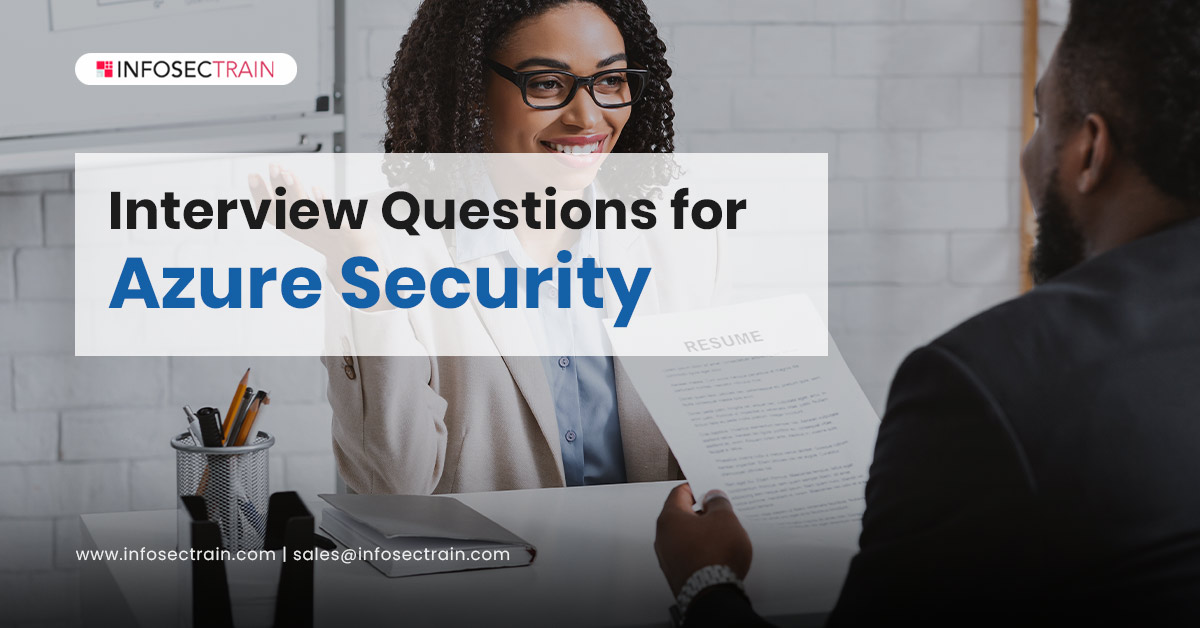Interview Questions for Azure Security
Cloud computing is revolutionizing how businesses operate in today’s digital landscape. According to a Gartner survey, Azure is the market’s second most popular cloud service provider. As Microsoft Azure grows in popularity, large enterprises around the world are becoming more Azure-centric than ever. As a result, these businesses want professionals that can manage the Azure cloud’s security posture, detect and remediate vulnerabilities, execute threat modeling, install threat prevention, and respond to security incident escalations.

However, as the industry’s demand for security experts grows, the interviews become more challenging. So, here are the latest Azure Security interview questions and answers.
Question 1: What do you understand about Microsoft Azure?
Answer: Microsoft Azure is the company’s public cloud computing platform, and it was formerly known as Windows Azure. It offers computing, analytics, storage, networking, and other cloud services.
Question 2: What do you understand about the Network Security Group (NSG)?
Answer: A Network Security Group (NSG) is a collection of security rules that allow or disallow incoming and outbound network traffic to and from various Azure resources.
Question 3: What are the security features of Microsoft Azure?
Answer: The following are the security features of Microsoft Azure:
- Key Logs
- Identity and Access Management (IAM)
- Secure Networks
- Malware protection
Question 4: How does Azure assist in the prevention of cyber-attacks?
Answer: Microsoft Azure platform invests over a billion dollars each year in cybersecurity. Azure’s computing architecture is made up of bespoke hardware with security features. Built-in DDoS protection to defend your resources from volumetric or protocol layer attacks. Finally, security is a shared responsibility between Microsoft and their customers. The central system for managing access to all cloud services is Azure Active Directory.
Data encryption controls are built-in from virtual machines to CosmosDB and Azure Data Lake. DDoS Protection Standard gives you more DDoS protection control over your virtual networks. Microsoft Defender for Cloud’s threat protection lets you discover and mitigate threats with security alert dashboards. The Microsoft Intelligence Security Graph combines signals from various Microsoft products at a large scale.
Question 5: What are Microsoft Azure break-fix issues?
Answer: Break-fix issues are a type of technical difficulty in Azure. It is an industry phrase for work associated with supporting a technology when it breaks in the ordinary course of its function and needs to be restored to working order by a support organization.
Question 6: How can you keep your data safe when transferred to the Azure cloud?
Answer: The following are the ways data can be secured:
- Encryption: Attached drives on Windows and Linux virtual machines are encrypted with Azure Disk Encryption. You can use Transparent Data Encryption (TDE) to perform real-time encryption and decryption of your databases. Always Encrypted can also be used with Always Encrypted to help protect sensitive data on the server while it is in transit.
- Access Controls: To restrict access to Azure resources, we can use Azure role-based access control (Azure RBAC). You can synchronize with Azure AD if you are using Active Directory on-premises. In Azure Active Directory, conditional access can be used to restrict application access.
- Network protection: You may need to isolate your whole communication route at times between your on-premises and cloud architecture. Use ExpressRoute or a virtual private network (VPN). Virtual network peering allows VMs in an Azure Virtual Network to communicate with those in other VNets securely.
- Rights management: Azure Rights Management is a cloud-based solution that encrypts files and emails using encryption, identity, and authorization controls. It works on various devices, including phones, tablets, and computers. Information can be safeguarded both within and outside of your firm.
Question 7: What is Azure VNet Security?
Answer: In the Azure cloud, VNets are separated by default. Each VNet has its own set of attributes, and a VNet is its own trust border.
Question 8: Is it possible to set up a separate firewall between VNet-connected resources?
Answer: Yes, the firewall, VNet, and public IP address must all be in the same resource group, though.
Question 9: What is Microsoft Defender for Cloud?
Answer: Microsoft Defender for Cloud is a collection of tools for monitoring and managing the security of virtual machines and other cloud resources in Microsoft’s public cloud.
Question 10: Which aspects of network security should a company consider?
Answer: The four most important components of network security are firewalls, Security Information and Event Management (SIEM), Network Access Control (NAC), and Intrusion Prevention Systems (IPS). Data Loss Prevention (DLP), antivirus and anti-malware software, application, online and email security, and more are among the options.
Question 11: Is Microsoft Defender for Cloud useful for enhancing security infrastructure?
Answer: By offering “at a glance” security updates via Secure Score, leveraging Azure rules behind the scenes, and keeping you compliant, the Microsoft Defender for Cloud can help you boost your security posture. Furthermore, the Microsoft Defender for Cloud’s recommendations can assist you in quickly resolving any security issues in your environment.
Question 12: What are the different encryption models available in Azure?
Answer: The following are the different encryption models available in Azure:
- Server-side encryption
- Client-side encryption
- Azure Storage Service Encryption
- Client-side encryption of Azure blobs
- Cosmos DB database encryption
- Azure disk encryption
- At-rest encryption in Data Lake
Question 13: What exactly do you mean when you say Network Access Control?
Answer: Network Access Control (NAC) is the process of keeping unauthorized users and devices out of a private network.
Azure supports various NAC like:
- Network layer control
- Route control and forced tunneling
- Virtual network security appliances
Question 14: What exactly do you mean by advanced threat protection?
Answer: Advanced Threat Protection (ATP) is a set of security technologies that protect against sophisticated malware and cyberattacks that target sensitive information. It can assist a company in adapting to cybercriminals’ ever-changing techniques and better anticipating and preventing costly security breaches.
Question 15: What do you mean by Azure Security Policies?
Answer: A security policy specifies the set of rules that should be applied to resources within a subscription. You set policies for your Azure subscriptions in Microsoft Defender for Cloud-based on your company’s security requirements, the type of apps in each subscription, and the sensitivity of the data in each subscription.
Question 16: What are Microsoft security patches?
Answer: Patches are brief pieces of code inserted or patched into the current code of a computer program. Microsoft security patches resolve security vulnerabilities and defects in Windows and related software.
Question 17: Explain Azure’s data encryption at rest.
Answer: To encrypt and decrypt huge volumes of data quickly, Azure’s Encryption at Rest solutions use symmetric encryption. Identity-based access control and audit policies must be used to keep keys in a secure location. A key-encryption key is used to encrypt data encryption keys held outside of safe locations.
Question 18: What are the security challenges in Azure.
Answer: Some of the security challenges with Azure are:
- Application-based attacks receive more attention than infrastructure-based attacks.
- Identity-based attacks are common.
- Securing Ports in Azure is a challenge.
- Firewalls are easy to set up, but they are less mature.
- Azure has a well-deserved reputation for being a closed environment.
Question 19: What is the role of an Azure Security Engineer?
Answer: Azure Security Engineers implement Azure security policies that secure identity, access, data, applications, and networks in cloud and hybrid environments.
Question 20: How would you secure an Azure-hosted application?
Answer: The Web Application Firewall (WAF) protects web applications that use the application gateway for conventional Application Delivery Control (ADC) functionality. Whenever possible, utilize the HTTPS protocol instead of HTTP, which can greatly improve security. Allowing unauthorized access or opening unwanted ports from outside networks is also a no-no.
How can InfosecTrain help you?
InfosecTrain is a renowned global provider of IT security, cloud, and cloud security training. We are an authorized training partner of Microsoft as well. You can participate in our Microsoft AZ-500: Azure Security Technologies training course to gain a deeper understanding of Azure security core services and capabilities, which will aid you in your interview preparation. As the course follows the AZ-500 certification curriculum, you will learn how to use the Microsoft Azure platform to develop secure infrastructure solutions quickly.




 1800-843-7890 (India)
1800-843-7890 (India) 
